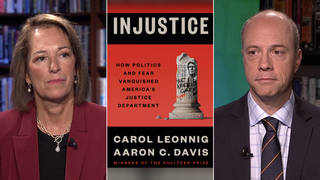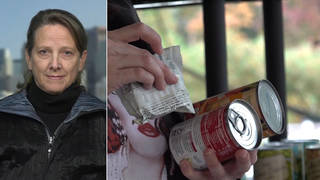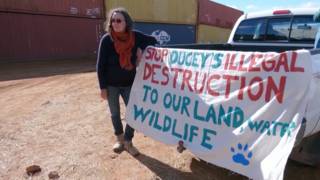
Topics
Guests
- John Carlos Freyaward-winning investigative reporter with The Marshall Project and special correspondent with PBS NewsHour. He is recently back from reporting trips in Guatemala and Nogales, Mexico, where he spoke with asylum seekers waiting for days and even weeks to enter the United States.
As the Trump administration continues an immigration crackdown at the border, asylum seekers are being told to wait for days or weeks on end before being allowed entry into the United States. This practice is leading more and more immigrants to risk their lives on dangerous journeys through the desert to enter the country instead, says investigative reporter John Carlos Frey. We speak with the Marshall Project reporter about the Barry Goldwater bombing range in Arizona, a vast swath of land across the border from Nogales, Mexico. The area is part of an incredibly dangerous migrant path, but aid workers are not allowed access to the site. Frey estimates hundreds of immigrants could have died there in recent years but that their bodies have not been recovered.
Transcript
AMY GOODMAN: John Carlos Frey, can you talk about the Barry Goldwater bombing range?
JOHN CARLOS FREY: Sure. The Barry Goldwater bombing range is a 70-mile stretch of land, owned by the federal government, where the military, mostly the Air Force, performs military exercises and bombing runs, basically training pilots, for military exercises. It is a cordoned-off area of the southern Arizona desert. It happens to cross through very well-known migrant routes. Migrants who are coming through the desert on their way to the United States sometimes cross the Barry Goldwater bombing range. It’s almost impossible to get to a major highway, where migrants usually pick up their ride, without crossing this bombing range.
The bombing range is restricted from humanitarian assistance, because of, for obvious reasons, it’s a dangerous place. And so, individuals who care for migrants on their journey, by putting out water, by putting out food, or maybe even searching for lost migrants, are not allowed onto this stretch of land. I had been in contact with a search-and-rescue team over the past six months, and they have discovered over a dozen bodies on a very small section of the Barry Goldwater bombing range when they had permission to search in this general area. It is believed that there are hundreds, if not more, individual human remains still there on the bombing range, but the federal government is not allowing anybody on to search for these individuals. Migrants cross there on a regular basis. That has been proven. And these individuals believe, at least the search-and-rescue groups believe, that there are many, many more bodies there, and the federal government is barring that process.
AMY GOODMAN: A mass grave of migrants on the Barry Goldwater bombing range—
JOHN CARLOS FREY: Easily, easily.
AMY GOODMAN: —right over the border from Nogales in Mexico, this in the United States.
JOHN CARLOS FREY: Absolutely. That’s correct.
AMY GOODMAN: Hundreds of bodies?
JOHN CARLOS FREY: Without a doubt. This search-and-rescue group, called Aguilas del Desierto, which means the “Eagles of the Desert,” was given permission to search a very small section of the south end of the bombing range, where there were no exercises being performed. And they were looking for an individual who was possibly still alive. They had a missing persons report, so they were given permission, over a weekend—I’m sorry, over two weekends—to search for this individual. That individual was not found, but in the process of searching for that missing person, they found 13 human remains, just in the course of two weekends, in a very small section of the bombing range. That, to this group, was proof that there must be at least hundreds more, if not more than that. They were the first group ever allowed to search on the bombing range.
And as I said, this is a part of a corridor that migrants cross. And if you get to the bombing range on your way to this road, you’ve probably already been walking for about five days in the desert, so you’re in pretty bad shape by the time you reach the bombing range. And you’ll have 30 more miles to go. So, it’s pretty likely that, as you say, there are hundreds of human remains still there. And the federal government doesn’t believe that—at least that’s what they say on paper—and are not allowing groups in.
AMY GOODMAN: In 2015, John Carlos Frey, you reported on a mass grave in Brooks County, Texas, that held the unidentified bodies of more than 300 immigrants, the bodies gathered from the desert. Your report found many of the immigrants died after crossing into the United States and waiting hours for Border Patrol to respond to their 911 calls. What is the latest on this?
JOHN CARLOS FREY: The forensic team that uncovered the bodies, exhumed the human remains and started to take the DNA samples and analyze the human remains for possible reunification with family members, have tried diligently to get these individuals back to loved ones, mostly in Latin America, and they’ve had difficulty. The process is complicated. But for the most part, law enforcement in the United States keeps the names of individuals who are deemed missing. Missing persons reports are handled by law enforcement agencies in the United States. Those law enforcement agencies, if they like or if they want to, are responsible for turning those names over to the missing persons database. For the most part, sheriffs, police departments, police agencies in the United States do not count migrants who are missing as missing persons. So these individual names are not being turned over to the database. So there’s no way for someone in Latin America to search for their loved ones through a DNA sample, because those names have not been entered in the database.
So the organizations that have exhumed the bodies, that are concerned about migrants, have started their own database. There’s one that a forensic team from Baylor University has put together called Yo Tengo Nombre, which means “I Have a Name.” And they have posted the actual identifying features of the individual who’s lost, the clothing that they may have been wearing, the jewelry that they may have had on their person. Any signs of what these individuals may have looked like are on this particular website, so that people looking for their loved ones in Latin America may go on there and say, “My daughter or my son was wearing a pair of jeans and a blue shirt.” Those photographs would be up. It’s a needle-in-a-haystack way of trying to get people reunited, but that’s, at least at this point, without putting individuals’ names on the database, on the missing persons database, is about the only way that people are ever going to be reunited.
As you say, close to 300 people were exhumed from these mass graves. And as far as I understand, only one individual has been reunited with its family. So, there is not much a government effort. The federal government has washed its hands of these individuals and is not assisting, either financially or by allowing names to be put into the database.
AMY GOODMAN: John, we only have 30 seconds.
JOHN CARLOS FREY: So, these—sure.
AMY GOODMAN: But I want to ask about the connection between these mass graves, whether we’re talking about Brooks County or the Barry Goldwater bombing range, and people waiting on the border even still, even now, day after day, trying to come in legally and then giving up and coming another way and risking their lives even further.
JOHN CARLOS FREY: There’s a direct correlation. Individuals who are trying to make a claim of asylum have fled their countries because they don’t have a choice. They’re fleeing for their lives. If we are not allowing them in to make a claim of asylum, they will go another way. And the route that’s available to them are the deserts of the American Southwest. It is most likely now that individuals who cross that desert will be put in peril. They will suffer just going through, especially this time of year. We can count on the fact that many of these individuals may perish.
AMY GOODMAN: John Carlos Frey, this is incredible reporting. I thank you for being with us, award-winning investigative reporter with The Marshall Project. We’ll do the interview in Spanish at democracynow.org.












Media Options